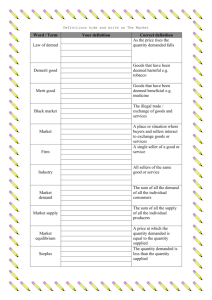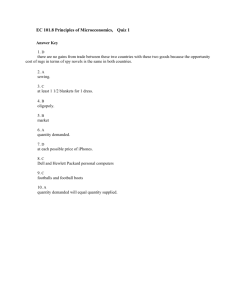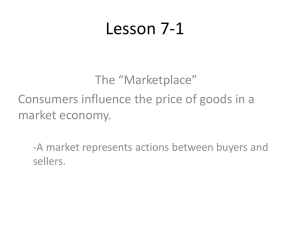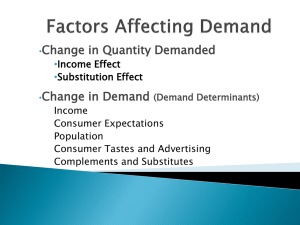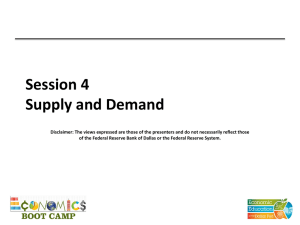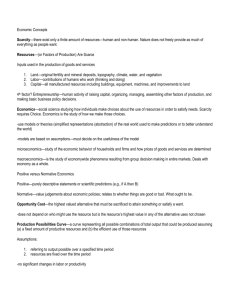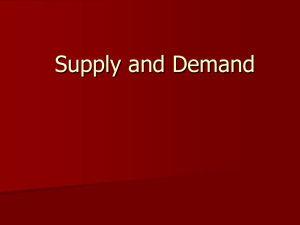Demand, Supply and Market Equilibrium
advertisement
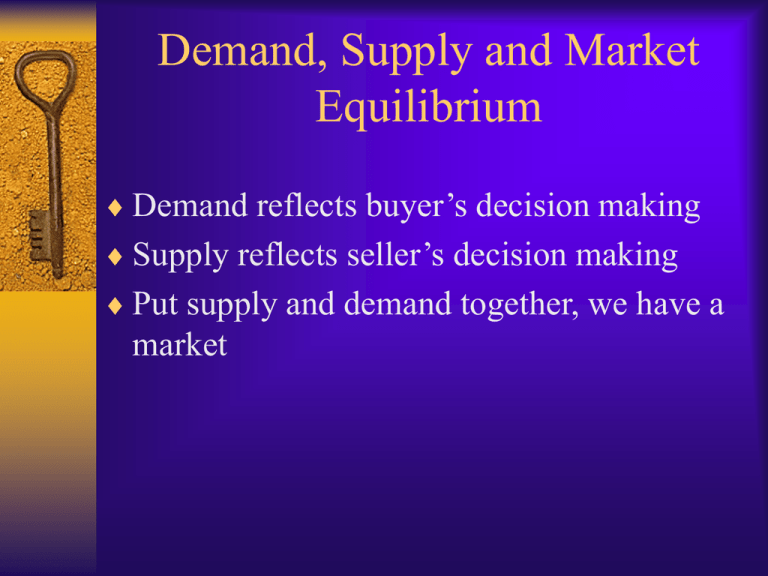
Demand, Supply and Market Equilibrium Demand reflects buyer’s decision making Supply reflects seller’s decision making Put supply and demand together, we have a market Demand The amount of a good or service that consumers are willing and able to purchase during a given period of time is called quantity demanded. We will simplify demand analysis by focusing on six critical factors that influence quantity demanded. Two Types of Demand Functions Generalized Demand Functions – which show how quantity demanded is influenced by the price of the product and five other factors. Ordinary Demand Functions – which focus on the relationship between price and quantity demanded, holding other factors constant. Generalized Demand Functions Qd f (P, M , PR , T , Pe , N ) Nature of the Relationship All six jointly determine quantity demanded. If want individual effects, must hold others constant - ceteris paribus condition Price and Quantity Demanded or or Qd f ( P, M , PR , T , Pe , N ) Price and quantity demanded are inversely related. If price increases, holding other factors constant, quantity demanded decreases. This inverse relationship is often referred to as the Law of Demand. Demand and Income or or Qd f ( P, M , PR , T , Pe , N ) For normal goods, income and demand are positively related. For inferior goods, income and demand are inversely related. Demand and Price of Related Goods or or Qd f ( P, M , PR , T , Pe , N ) For complements, PR and demand are inversely related. For substitutes, PR and demand are positively related. When are two goods substitutes? Complements? Demand and Tastes or or Qd f ( P, M , PR , T , Pe , N ) For this one, I have assumed that an increase in tastes is an indication that consumers perceive the product more favorably and thus are willing and able to purchase more. Demand and Price Expectations or or Qd f ( P, M , PR , T , Pe , N ) If consumers perceive that an increase in prices is likely in the future, the current level of demand will increase. Demand and Number of Buyers or or Qd f ( P, M , PR , T , Pe , N ) If the number of buyers increase, demand will increase. Abbreviated Demand Model Drop tastes – not measurable and not always relevant – Tastes for telephones Drop number of buyers – often doesn’t change during time period of analysis Drop price expectations – difficult to measure and only relevant for some goods – Expect price of toilet paper to increase – Expect price of telephone service to increase Demand Functions Demand or the demand function is the relationship between price and quantity demanded, holding other factors constant. – Table: see slide following – Graph: see slide following – Equation: Qd=2000-20P Demand Schedule Price Qd=2000-20P 0 2000 25 1500 50 1000 75 500 100 0 Demand Curve P Q = 2000-20P 100 50 1000 2000 Qd Changes in Demand vs Changes in Quantity Demanded A change in the price of the product, results in a movement along the demand curve and is said to result in a change in quantity demanded. A change in any of the other (five) factors in the demand function , results in a shift in the demand curve and is said to result in a change in demand. Supply Quantity supplied is the amount of a good or service offered for sale in a market during a given period of time. The quantity of a good offered for sale is based on six factors. Factors Influencing Supply Decisions Price + Input prices Prices of related goods in production – – for substitutes (wheat and corn) – + for complements (oil and gas) Technology + Price expectations Number of sellers + see Table 2.5 Generalized Supply Function Relationship depicting how all six factors jointly determine quantity supplied. Qs=g(P, PI,Pr,T,Pe,F) Supply Function Shows the relationship between Q and P, holding constant the other 5 factors. These other factors are called the determinants of supply. Change in Supply versus Change in Quantity Supplied A change in price causes a change in quantity supplied and is reflected by a movement along a fixed supply function. A change in any of the determinants of supply causes a change in supply and is reflected by a shift in the supply function. Supply Schedule A table showing a list of all possible prices and the corresponding quantities supplied. Price 65 60 50 40 30 20 10 Q Supplied 750 700 600 500 400 300 200 Supply Curve A graph showing relationship between price and quantity supplied P S Q Supply Shifts – Increase Versus Decrease P S0 Q Market Equilibrium S P* D Q* Excess Supply-Surplus S P1 P* D Q* Excess Demand - Shortage S P* P2 D Q* Market Equilibrium-Changes in Demand S P* D Q* Market Equilibrium-Changes in Supply S P* D Q* Market EquilibriumSimultaneous Changes in S & D S Indeterminate? P* D Q* Qualitative versus Quantitative Market Forecasting Qualitative – only direction is predicted Quantitative – direction and magnitude is forecasted Price Fixing Price Ceiling – Maximum price is mandated – Shortages result – Potential for Black Market Price Floor – Minimum price is mandated

